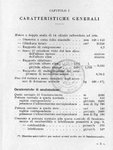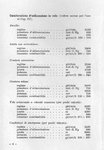Navigation
Install the app
How to install the app on iOS
Follow along with the video below to see how to install our site as a web app on your home screen.
Note: This feature may not be available in some browsers.
More options
You are using an out of date browser. It may not display this or other websites correctly.
You should upgrade or use an alternative browser.
You should upgrade or use an alternative browser.
FIAT A74 RC38 performance
- Thread starter greybeard
- Start date
Ad: This forum contains affiliate links to products on Amazon and eBay. More information in Terms and rules
More options
Who Replied?- Thread starter
- #3
secondo il manuale del G-50 Bis a pagina 100, "la potenza normale sviluppata dal motore.... alla quota di mt 3800 con la pressione di alimentazione di 790 m/m Hg ed a 2400 giri al minuto è di 840 cv" " a quota 0 la potenza è di 740 cv" (pagina 101 stesso regime del motore). il +100 è permesso solo nei decolli, nei casi in cui è strettamente necessario (nel manuale del C.200 VII serie è specificato comunque non più di 3 minuti). Da tenere presente che i giri massimi per il motore sono 2500+20 e questi sono i giri indicati per i voli a velocità massima, ma specificati di durata limitata/brevi periodi (secondo il manuale), quindi il motore può dare di più dei 840 cv della potenza di omologazione, se è proporzionale ai giri, 882 cv.
- Thread starter
- #5
Grazie per le preziose informazioni.
Piero Vergnano, nel suo "I caccia FIAT 1930-1945", da come potenza massima 870 CV a 2520 giri/min per un massimo di 3 minuti.
Devo interpretare i 740 CV a 2400 giri/min e 790 mm Hg come massima potenza continua a quota zero?
Conosci anche un regime inferiore, tipo di crociera economica e la relativa potenza e pressione di alimentazione?
Grazie ancora e buonanotte.
Piero Vergnano, nel suo "I caccia FIAT 1930-1945", da come potenza massima 870 CV a 2520 giri/min per un massimo di 3 minuti.
Devo interpretare i 740 CV a 2400 giri/min e 790 mm Hg come massima potenza continua a quota zero?
Conosci anche un regime inferiore, tipo di crociera economica e la relativa potenza e pressione di alimentazione?
Grazie ancora e buonanotte.
per quanto riguarda i regimi di crociera il manuale del 50 Bis indica di mettere il motore sui 2200 giri e la pressione a 650 mm (il tutto è consigliato per una quota di 6 km) con la possibilità di variare la pressione secondo le circostanze e le necessità fra i 500 e i 790 mm. il manuale del 200 VII serie consiglia una crociera economica a 2100 giri e 590 mm (quota 5 km), per la crociera veloce 2400 giri e 700 mm (stesse indicazioni sono presenti anche sul manuale delle serie I/V). Sfortunatamente non sono indicate le potenze espresse a tali regimi.
per i 740 ritengo di si, come avevo detto io non ho mai trovato limiti di tempo riguardo la potenza di omologazione del A74
per i 740 ritengo di si, come avevo detto io non ho mai trovato limiti di tempo riguardo la potenza di omologazione del A74
- Thread starter
- #7
I have an excerpt of an unknown book stating some data about italian aircraft engines. Powers for the A.74 RC38 are given as:
2400 rpm, 740 hp at sea level and 840 hp at 3800m (normal output)
2520 rpm, 870 hp at sea level (take-off rating)
Book states performance figures are tested in altitude chamber, I don't know if the given values are really hp or metric PS (I assume Italy did not use imperial hp).
2400 rpm, 740 hp at sea level and 840 hp at 3800m (normal output)
2520 rpm, 870 hp at sea level (take-off rating)
Book states performance figures are tested in altitude chamber, I don't know if the given values are really hp or metric PS (I assume Italy did not use imperial hp).
- Thread starter
- #10
Vergnano's book doesn't give altitude for 870 CV power, but I think it's meant at sea level, as mentioned by Denniss.
Power outputs are all in metric unit of measure, CV=Cavalli Vapore, each equal to 75 kgm/s. Often british sources neglect conversion, which is 1CV=0.986 HP (1HP=550 lbft/s). Curiously, german PS, initially wasn't quite the same, being expressed in lbft/s too and different for various regions.
GB
Power outputs are all in metric unit of measure, CV=Cavalli Vapore, each equal to 75 kgm/s. Often british sources neglect conversion, which is 1CV=0.986 HP (1HP=550 lbft/s). Curiously, german PS, initially wasn't quite the same, being expressed in lbft/s too and different for various regions.
GB
Tzaw1
Airman 1st Class
Se manual here: AVIA - Associazione di Volontariato in Italia per l'Aviazione
Attachments
- Thread starter
- #14
- Thread starter
- #16
- Thread starter
- #18
I think it's matter of dynamic pressure. I mean, power of "caratteristiche di omologazione" is probably got at dynamometer (banco prova motori) whilst that in flight takes in account (it's anyway a computed one, not measured, obviously) further raise in rated altitude (quota di ristabilimento) due to speed of air that becomes pressure into intake manifold. This allows to get same 840 CV "static" at 3800 m, at 4300 m, still with same MAP. Can't explain the higher RPM.
- Thread starter
- #20
The "ram" air effect is ascertained; I mean, that's routine for that category of aircraft engines. About the 2520 RPM, I don't think that could be an error (those documents were approved by fascist government, which was no soft about mistakes! lol), since also G50bis manual mentions at page 122 to get velocità massima at 2500 RPM and not 2400. Simply, I'm unable to explain.
Ciao,
GB
Ciao,
GB
Users who are viewing this thread
Total: 1 (members: 0, guests: 1)


